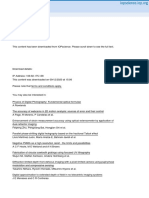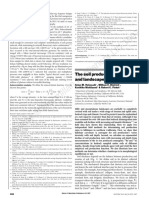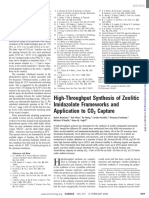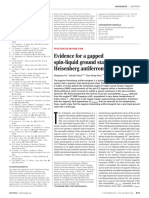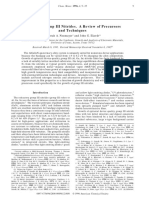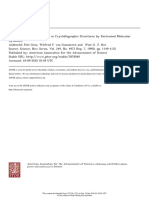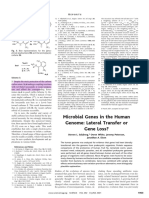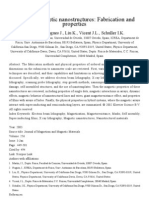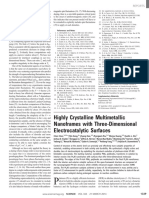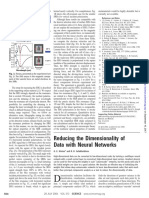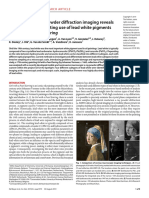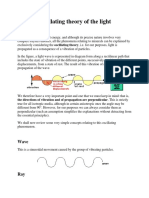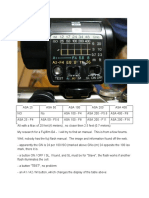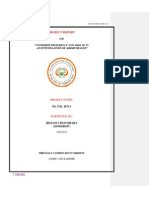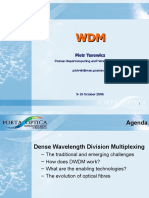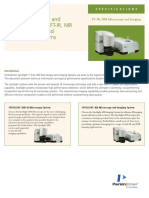Nicewarner Pena2001
Nicewarner Pena2001
Uploaded by
malavikamanoj4420Copyright:
Available Formats
Nicewarner Pena2001
Nicewarner Pena2001
Uploaded by
malavikamanoj4420Original Title
Copyright
Available Formats
Share this document
Did you find this document useful?
Is this content inappropriate?
Copyright:
Available Formats
Nicewarner Pena2001
Nicewarner Pena2001
Uploaded by
malavikamanoj4420Copyright:
Available Formats
R E P O R T S
of the catalyst, including selectivity for the annealing t o about 1100 K. The quality of the ground state essentially instantaneously with the
case of more complex catalytic pathways. surface preparation was checked with low-energy movement of the laser spot.
electron diffraction. 34. 5. VBlkening J. Wintterlin, J. Chem. Phys. 114, 6382
Figure 2B suggests the local regeneration of 32. H. H. Rotermund, C. Haas, R. U. Franz, R. M.Tromp, C. (20011.
deactivated areas as one possible starting Ertl, Science 270, 608 (1995). 35. 6. Y. icuan, H. T. Davis, R Aris, Chem. Eng. Sci. 38,
point for such a design. In the case of island- 33. We have measured the spatiotemporaltemperature 719 (1983).
profile of our laser spot using a cooled infrared (IR) 36. C. 1. Pappas, C. Lafferriere, 5. Sastry, IEEE Trans.
forming reactants, for which the reaction oc- camera with a temperature resolution of 0.05 K at Autom. Control 45, 1144 (2000).
curs at the perimeter of these islands (34,35), roomtemperature. Fromthose IR images we deduced 37. M. D. Graham et al., Phys. Rev. E 52, 76 (1995).
the generation of additional boundaries a maximum differential temperature rise at the spot 38. We gratefully acknowledge partial support by the
should enhance reaction rates. What are good of about 15 K; typically, we worked at powers giving Office of Naval Research (I.C.K. and H.H.R.), NSF, Air
a temperature rise of 2 to 3 K over an area of -80 Force Office of Scientific Research,and the Humboldt
feedback laws for these objectives, and how pm in diameter. Detailed heat balance simulations, Foundation (I.C.K.), and by a Marie Curie Fellowship
can they be implemented? Hierarchical con- includingradiationand conduction, showed that only (A.C.P.) under contract HPMFCT-2000-00685. We
trol schemes (36) may be key to the practical 5 ms were neededto locally establishthis differential thank M. Pollmann for the measurement of Fig. 1C
temperature rise, confirmingour experimental obser- and 5. Shvartsman for many discussions.
implementation of real-time feedback with vation of a heat quench in less than 20 ms. In other
finely distributed actuation. words, the temperature rises and returnsto its back- 19 June 2001; accepted 28 August 2001
References and Notes
1. 1. A. Lundqvistet al., Pmc. Natl. Acad. Sci. U.S.A. 95,
10356 (1998).
2. Y. S. Matros, G. A Bunimovich, Catal. Rev.-Sci. Eng.
Submicrometer Metallic
38, 1 (1996).
3. M. X. Yang D. H. Gracias, P. W. Jacobs, C. A Somorjai,
hngmuir 14, 1458 (1998).
Barcodes
4. K. Wong 5. Johansson, B. Kasemo, Faraday Discuss.,
105, 237 (1996). Sheila R. Nicewarner-Peiia,' R. Criffith Freeman?
5. R. Srinivasan et al., AIChE J. 43, 3059 (1997). Brian D. Reiss,' Lin He? David J. ~eiia,' Ian D. Walton?
6. A. L. Lin et al., Phys. Rev. Lett. 84, 4240 (2000).
7. V. Petrov, V. Caspar, J. Masere, K. Showalter, Nature Remy Cromer? Christine D. KeatingS1*Michael J. at an**
361, 240 (1993).
8. M. Kim et al., Science 292, 1357 (2001). We synthesized multimetal microrods intrinsically encoded with submicrome-
9. H. H. Rotermund, Surf. Sci. Rep. 29, 265 (1997).
10. , W. Engel, M. Kordesch, C. Ertl Nature 343,
ter stripes. Complex striping patterns are readily prepared by sequential elec-
355 (1990). trochemical deposition of metal ions into templates with uniformly sized pores.
11. S.lakubith, H. H. Rotermund, W. Engel, A v. Oertzen, The differentia1,reflectivity of adjacent stripes enables identification of the
G. Ertl, Phys. Rev. Lett. 65, 3013 (1990). striping patterns by conventional light microscopy. This readout mechanism
12. F. Mertens, R. Imbihl, Nature 370, 124 (1994).
13. M. D. Graham et al., Science 264, 80 (1994). does not interfere with the use of fluorescencefor detection of analytes bound
14. J. Lauterbach et al., Physica D 123, 493 (1998). t o particles by affinity capture, as demonstrated by DNA and protein bioassays.
15. S. Y. Shvartsman, E. Schiitz, R. Imbihl, I. C. Kevrekidis,
Phys. Rev. Lett. 83,2857 (1999).
16. M. Kolodziejqk, R. E. R. Colen, B. Delmon, J. H. Block,
Multiplexing and miniaturization are becom- umes has led to innovativedevices for sample
Appl. Surf. Sci. 121, 480 (1997). ing pervasive themes in bioanalysis. The manipulation [e.g., chip-based microfluidics
17. F. Esch et al., Catal. Lett. 52.85 (1998). push to measure ever-increasing numbers of ( I ) ] and ingenious approaches to simulta-
18. Y. 5. Matros, Can. j. Chem. Eng. 74, 566 (1996). species from smaller and smaller sample vol- neous measurement capabilities (e.g., mi-
19. 1. C. Khinast, D. Luss, Comput. Chem. Eng. 24, 139
(2000).
20. 5. K6d6r. J. Wang K. Showalter, Nature 391, 770
(1998). Fig. l. Synthesis of
21. 0. Steinbock V. Zykov, S. C. Miller, Nature 366,322 AI2O3membrane after barcoded particles.
(1993).
22. E. D. Sontag.MathematicalControlTheory: Determin- Ag evaporation and
istic Finite-Dimensional Systems (Springer-Verlag initial Ag
Berlin, ed. 2. 1998). electrodeposition
23. E. Ott, C. Crebogi, J. A. Yorke, Phys. Rev. Lett 64,
1196 (1990).
24. V. S. Zykov, A. S. Mikhailov, 5. C. Miiller, Phys. Rev.
1. Au+ + e- + Au x Coulombs (C)
1
Lett. 78, 3398 (1997).
25. D. Semowogerere, M. F. Schatz, Bull. Am. Phys. Soc. 2.Ag++e-+Ag xC
45, 46 (2000). 3. Au+ + e- + Au 2x C
26. R. Roy, K. S. Thornburg Jr., Phys. Rev. Lett. 72, 2009 4.Ag++e-+Ag xC
(1994).
27. V. K. Vanag. L. Yang. M. Dolnik, A. M. Zhabotinsky, 5.Aut+e-+Au xC
I. R. Epstein, Nature 406, 389 (2000).
28. Desired spatiotemporal heating patterns could be
programmed into the control computer by using
LabVIEW. In addition, it was possible to control the
laser spot on the surface by hand directly, using the
computer mouse. This joystick mode establishes--as
in computer games or flight simulators--a direct
feedback with the human brain as image Drocessor
1 1
and control action calculator. For our c&bter-con- 1. Ag film dissolution with HN03
trolled feedback experiments, real-time image pro- 2. AI2O3dissolution with NaOH
cessingand desired rulesfor the heatingpatternsand
intensitieswere implemented in software.
29. 0. Steinbock, 1. Schiitze, S. C. Miiller, Php. Rev. Lett.
68, 248 (1992).
30. A. P. Munuzuri, M. Dolnik, A. M. Zhabotinsky, I. R
Epstein, J. Am. Chem. Soc. 121, 8065 (1999).
31. In our experiments, the Pt(ll0) single-crystal sam-
ple was kept in an ultrahigh-vacuum apparatus.
The surface was prepared by Ar-ion sputtering and
www.sciencernag.org SCIENCE VOL 294 5 OCTOBER 2001
REPORTS
croarrays and encoded, micrometer-sized incorporated seven different metals (Pt, Pd, as well as those typically applied to bulk
polymericbeads). Microarrays (2) exploit po- Ni, Co, Ag, Cu,and Au) in segments as short materials [atomic absorption, optical reflec-
sitional encoding to carry out large numbers as 10 nm and as long as several micrometers, tivity (Id)].
of analyses in parallel, but they can suffer and have prepared particles with as many as Images of a 4.5-km-long Au cylinder
ftom slow diffusion of analytes to the surface 13 distinguishablestripes. Moreover, the pro- with a single Ag segment near one end were
(3) and limitations in the range of analyte cess used to fabricate these materials is ame- generatedby electron and optical microscopy
concentrations that may be detected simulta- nable to automation.Particle characterization (Fig. 2A). Although the electron micrograph
neously. In the case of microbeads, encoding has included techniques well suited to metal has higher resolution, the striping pattern is
is accomplished by incorporation of mole- nanoparticles [electron and scanning probe clearly apparent in the optical image. The
cules (4-6) or, as recently described, nano- microscopies, optical extinction spectra (IS)] physical basis for the optical contrast be-
particles (7) with distinctive fluorescent sig-
natures. G a y s of beads in solution circum-
vent the shortcomings of planar microarrays
for assay development.
However, the number of bead-based as-
says that can be performed simultaneously
is limited by the number of spectrally dis-
tinguishable fluorophores. This number is
further constrained when, as is often the
case, a fluorophore is required for analyte
quantitation. If encoding did not depend on
fluorophore incorporation, then particles
should retain the advantages of solution
arrays with increased levels of multiplex- Live rru WmgIUUl lU u
ing. Here, we describe the electrochemical used in (A) but not in
the other o ical im-
manufacture and optical characterization of aga here.] $1 Upper
striped, cylindrically shaped metal nano- panel: Wavelength d e
particles that can be identified by the pat- pendence of reflectii-
tern of differential optical reflectivity of ityfor bulk metals [this
adjacent stripes. Because many thousands P P ~ was generated
of uniquely identifiable particles can be from values reported
in (7711. Lower panel:
prepared, and because such particles can be Ratio of reflected in- 0 . 2 , .
used in fluorescence- and mass spectrom- 400 600 800 loo0
tensities for various Wavelength (nm)
etry-based assays, they enable a wide va- metals versus Au at
riety of bioanalytical measurements. 430 nmfor bulkmate
Suspensions of barcoded particles were rials (open triangles) a Bulk Metal
prepared by sequential electrochemical re- and for striped parti-
cles. Forthe latter,val-
duction of metal ions into the pores of mem- ues were experimen-
brane templates (8, 9), followed by particle tally determinedusing
release (Fig. 1) (10). A silver film deposited reflectanceoptical mi-
a"
on the backside of an Al,O, membrane croscopy. (C) Reflec-
serves as the working electrode for reduction tance optical micros-
of metal ions from solution. The structure of copy image of an Ag-
Au-Ag barcode rod
each particle type is controlled by (i) the (length -10 pm).Top:
membrane pore diameter, which sets the par- High contrast was ob-
ticle width; (ii) the sequence of metal ions served between Ag
introduced into solution, which defines the (brighter sections) and
number and pattern of metal stripes; and (iii) Au (dark middle sec-
the charge passed in each step, which dictates tion)with 430-nm illu-
mination. Battom: No
stripe length. Alumina or polycarbonate contrast using600-nm
membrane templates with nominal pore di- excitation. (D) Reflec-
ameters ranging ftom 15 nm to 12 km are tance optical micros-
commerciallyavailable (11); well-defined al- copy images and line
ternative templates potentially include those profilesfor a particle
generated by interference photolithography of composition Au-
Ag-Ni-Pd-Pt with il-
(12), self-organization of block copolymers lumination at 430
(13), and electrochemical oxidation of nano- nm, 520 nm, and
indented bulk A1 (14). To date, we have 600 nm, respective-
ly. Samples were 1 2 3 4 5 1 2 3 4 5 1 2 3 4 5
mounted on elass Length (Im) Length (Im) Length (Im)
'Department of Chemistry, Pennsylvania State Uni- slides and imaged
versity, 152 Davey Laboratory, University Park, PA with a Nikon TE-300 inverted microscope equipped with a bright-field reflectance filter set
16802. USA. 2SurroMed Inc., 2375 Garcia Avenue, (containinga 50150 beam splitter) usinga 100X oil immersion lens (NA = 1.3). A 100-W Hg lamp
Mountain View, CA 94043, USA. with a 430-, 520-, or 600-nm (?I0 nm) bandpass filter was used for excitation, as indicated. All
*To whom correspondence should be addressed. E- particles shown here and in subsequent figures were prepared by electrodepositionin the pores of
mail: keating@chem.psu.edu, mnatan@surromed.com 0.2-~m(7 1) Anodisc (Whatman) alumina membranes (8-70).
5 OCTOBER 2001 VOL 294 SCIENCE www.sciencernag.org
REPORTS
tween Au and Ag segments is the difference other metals have intermediate reflectivities, follows. At the Rayleigh limit, the smallest
in reflectivity of the two metals. Reflectance suggesting the possibility of using more than distance between two resolvable points is =
data for bulk metals (17) are plotted in Fig. two intensity levels for optical encoding. Im- A/2(NA), where NA is the numerical aperture
2B (top panel) as a function of incident wave- ages of a single multimetal particle with blue, of the objective lens (18). Thus, optical res-
length. Although barcoded particles have at green, and red illumination are shown in Fig. olution is optimized when particles are read
least one dimension on the order of the inci- 2D; the wavelength dependence of reflectiv- using short wavelengths and high NA (e.g.,
dent wavelength, their reflectivity properties ity for each segment follows that predicted in NA = 1.4, an oil-immersion lens). This gives
are largely bulk-like. For example, Fig. 2B Fig. 2B. Note that Au is readily distinguished 400/(2 X 1.4) = 143 nm minimal spacing
indicates that bulk Ag is -2.5 times as re- from Ni, Pt, or Pd by its high reflectivity at between segments. For reliable readout of the
flective as bulk Au at 430 nm, whereas at 600 600 nm. The linescans below each image of barcode patterns, stripe lengths should be
nm they are equivalent; we observe this ex- Fig. 2D show variations in intensity of re- well above the optical resolution limit. For
perimentally in the striped particles. Figure flected light along the length of the particles. example, for a 6.5-pm coding length with
2C shows an Au-Ag-Au particle imaged at At 520 nm, four different metals (Au, Ag, Ni, 500-nm stripes (well above the diffraction-
these two wavelengths. The brighter sections and Pd) could be differentiated on the basis of limited spacing), a total of 13 segments are
correspond to Ag (and are -2.5 times as the intensity of their reflectivities in the obtained. With two metals (e.g., Au and Ag),
bright); the darker section corresponds to Au. linescan. the number of barcodes possible is 4160 (19,
Illuminating the same particle with 600-nm Optical reflectivity can be used to read out 20). This value is already far greater than the
light yields an image in which the metal the striping pattern encoded in the metal par- number of distinguishable fluorophore-based
segments are indistinguishable. ticles during their synthesis. Most of the met- tags of any variety (6, 7, 21, 22). With three
We have compared the experimentally ob- al segments shown in Fig. 2 were relatively metals, 8.0 X los distinctive striping patterns
served values for Au, Ag, and several other large, but much shorter segments can be syn- are possible (23).
metals to those expected for bulk materials. thesized. The lower limit for stripe length will For adjacent metals with high contrast, it
These data (Fig. 2B, lower panel) indicate arise not in preparation, but rather in identi- should be possible to optically detect very
that agreement between metal stripes and fication of the striping patterns. Given that a short stripes. To that end, we have synthe-
their bulk counterparts is quite good. At 430- preferred mode of readout is by optical mi- sized and optically detected Ag segments as
nm excitation, the greatest contrast observed croscopy, the diffraction-limited coding po- small as 50 nm in Au rods. Figure 3 shows
is that between Au and Ag. However, several tential of barcode rods can be estimated as optical and field-emission scanning electron
microscopy (FE-SEM) images of the same
Fig. 3. Optical (A) and Au-Ag multistriped particle, which contains
FE-SEM (B) images of an Ag stripes of lengths from 240 nm down to
Au-Ag multistripe parti- 60 nm, separated by 550-nm Au segments.
cle with -550-nm Au Because the Ag stripes are separated by sev-
stripes and Ag stripes of eral hundred nm, they are optically detect-
240, 170, 110, and 60 able. Thus, it should be possible to distin-
nm (top to bottom). The
same particle is shown guish large numbers of barcode patterns.
in both images. Particles Polydispersity in the length of electroplat-
were placed on an Au ed segments is a critical factor in determining
finder grid (Electron Mi- how many distinguishable particle "flavors"
croscopy Sciences) to can be prepared. For Au cylinders, an 8%
facilitate identification standard deviation in overall length has been
and imaging of the same
particles by both tech- reported (10). The monodispersity of striped
niques. FE-SEM data particle synthesis can be seen in Fig. 4A, an
were acauired using optical reflectivity image for a batch of Au-
backxattehng detection on a JEOLJSM-6320F at Accurel Inc (Sunnyvale, California). A ~ - A U - Apartidles.
~ The overall length of
jective. lllumination
was provided by 175-W Xe lamp and Liquidlight Guide (Sutter Instruments, (Chroma). (B) Mixture of nine barcode batches with different striping pat-
Novato, Califomia) filtered with a HQ 405-nm, 20-nm bandpass filter terns. Particle "flavors" in increasing binary order: 0000000, 0000001,
(Chroma Inc, Brattleboro, Vermont). llluminationwas split with a 50150 BS 0000010,0000100,0001000,0001010,001 1100,0100010, and 0101010.
www.sciencemag.org SCIENCE VOL 294 5 OCTOBER 2001 139
REPORTS
these particles, as determined by optical mi- layers that resist nonspecific binding by pro- be done simultaneously). To demonstrate that
croscopy, is 4.5 + 0.4 pm. With 10% stan- teins have been described (27). The striping barcoded rods can be used as supports for
dard deviation in stripe length, it should be pattern can be used to identify which chem- bioassays, we have adapted DNA hybridiza-
possible to distinguish between one and two istry has been immobilized on the particle, in tion and immunoassays for use on barcodes.
adjacent stripes, down to stripe lengths of much the same way as position encodes in- Figure 5A shows a particle-based "sandwich"
5350 nm (24, 25). Figure 4B shows a mixed formation in conventional microarray exper- hybridization assay. A 24-nucleotide oli-
population of -4.3-pm-long particles with iments. Although the particles are microme- gomer (the analyte) binds to a 12-nucleotide
several different barcode patterns, each of ters in length, their relatively small width capture sequence on the particle surface and
which is readily identifiable. The particle makes it possible to keep the particles in is later detected by addition of a 12-nucleo-
striping pattern can be used to encode infor- suspension by agitation to provide more rapid tide probe sequence that is complementary to
mation, for example, the identity of sur- mixing between the particles and target the remaining 12 nucleotides and carries a 3'
face capture chemistry for a particle-based molecules. fluorescent tag (28). Each individual particle
bioassay. Perhaps the most straightforward means can be seen in both the fluorescence (Fig. 5A,
Derivatization chemistries for metal sur- to detect andlor quantify analyte binding to i) and reflectivity (ii) images. When the ana-
faces and metal nanoparticles are well devel- barcoded particles is by fluorescence imag- lyte is omitted, a very low fluorescence back-
oped, ranging from nonspecific direct adsorp- ing. Because analyte identity is determined ground is observed (iii), and particles are
tion (e.g., of polymers or proteins) to more by barcode reflectivity readout, only'one flu- visible only in the reflectivity image (iv). The
specific-metal-adsorbateinteractions such as orophore is necessary to detect a variety of selective detection of DNA hybridization on
occur in alkanethiol self-assembled monolay- biomolecules. If multiple fluorophores are single optically encoded particles is an im-
ers (26).This rich chemistry enables the cou- used, an even greater level of multiplexing is portant first step toward multiplexed hybrid-
pling of a wide variety of capture reagents possible (e.g., with n barcode patterns and ization assays.
onto barcoded particles. In particular, mono- three fluorophores, 3n different assays could We have also performed simultaneous
sandwich imrnunoassays on two different
barcoded particles (1 = 4-pm-long Au-Ag-
Au, 2 = 8-pm-long Au-Ni-Au). Rods of type
1 were derivatized with capture antibody to
human immunoglobulin G (IgG), whereas
rods of type 2 were similarly derivatized with
capture antibody to rabbit IgG. The samples
were mixed and exposed to both analytes
(i.e., human IgG and rabbit IgG), after which
they were exposed to secondary antibodies.
To test the selectivity of the chemistries, we
labeled each secondary antibody with fluoro-
phores of different colori (green for antibody
to human IgG, red for antibody to rabbit
IgG). The results of this experiment are
shown in Fig. 5B; a reflectance image enables
the identification of the particles, and the
fluorescence images show the same particles
with filter sets for green and red fluorescence,
/ - i :,ti. -.-:?-.. , ,. ..4,-.
:$;:pLr?::~
i-/:
.'::.*
&&
* .<: ...2~<4!
k, ~..J!*C.
iii
respectively. Note that the green fluorescence
emanates predominantly from particles of
type 1, and red predominantly fiom type 2.
This indicates that the specific capture chem-
-
#
.*, istries on the two classes of particles were
/
' >
P J W.. ,
' i ,a
drrR."t;K.. '!:. , ? \ . , . . -
kt,&$ ,tp,+<,,*A29;
able to selectively bind their target analytes.
Although a very low level of nonspecif-
>
i s ( . 2% @s~p;:j&:;. ic binding can be observed (i.e., as a small
f *;.l*2;,:. ;.
amount of red fluorescence on the Ag-Au-
Reflectivity Texas .,-&,.. +.:. j:.-.
4E?';,Rigci
Ag particles, and green on the Au-Ni-Au
boonm FIE ,:;2;~$
Reti 1:?;, particles), these results demonstrate that
Fig. 5. Bioassays performed on barcoded particles using simultaneous immunoassays can be per-
fluorescence detection. (A) "Sandwich" DNA hybridiza- formed on rods and that the reflectivity
tion assay [see scheme on right (29)].Panel (i) reveals the image is sufficient for identification of the
fluorescence readout; (ii) shows the rod ID. The analyte,
capture chemistry on a given particle. Thus,
b, was omitted in the control sample. Panels (iii) and (iv)
show the fluorescence readout and the rod ID, respec- even if we had used only one fluorophore in
tively. Fluorescence images were obtained using the this experiment, it would have been possi-
"wide green" filter cube (Nikon). (0) A simultaneous ble to distinguish between the.human and
sandwich immunoassay performed on barcode rods. A rabbit IgG solely on the basis of the bar-
scheme depicting the configuration of such assays is code of the particles.
shown below the microscopy images (30). Panel (i) shows the reflectance optical microscopy To a certain extent, the barcode pattern is
image, which gives the barcode rod ID; (ii) and (iii) show the fluorescence readout with FlTC and
Texas Red filter sets, respectively. All three images are of the same sample location. Samples visible in the fluorescence images. This can
for (A) and (B) were mounted between a glass cover slip and slide using a Secure-Seal spacer be explained to a first approximation simply
(Molecular Probes. Eugene, Oregon) and viewed with optical and instrumentation as in Fig. 2. by the wavelength-dependent reflectivities of
5 OCTOBER 2001 VOL 294 SCIENCE www.science
these metals. By choice of metal and fluoro- cles selected for ease of identification (i.e., by com- heating to 60°C with passive cooling to room temper-
puter software). ature in the water bath. The samples were rinsed and
phore, it is also possible to "hide" the barcode 24. More than 95% of all 1X segments will be shorter detection proceeded by hybridization with a TAMRA-
pattern in fluorescence images. than 500 nm + 2(10%) = 600 nm, and >95% of all labeled detection oligomer, c (4 pM), for 2 hours at
As interest grows in canying out com- 2 x segments will be longer than 1000 nm - 30°C. After hybridization, the samples were rinsed first
2(10%) = 800 nm (25). For 350-nm segments, with 1% SDS in 0.3 M PBS, then with 0.1% 5DS in 0.3
prehensive analyses on classes of biologi-
>95% of all 1 x segments will be <420 nm, whereas M PBS, and finally with 0.3 M PBS.
cally relevant molecules (e.g., genomics, 95% of all 2X segments will be >560 nm. Although 30. Particles were derivatized with 16-mercaptohexade-
proteomics, metabolomics), there is a de- the differences in these two lengths cannot be di- canoic acid to which the capture antibody, a, was
mand for very high-level multiplexing in rectly measured by optical microscopy, they should covalently attached using standard carbodiimide chem-
be distinguishable by differences in intensity. Note istry. For this assay, Au-Ag-Au rods were derivatized
small sample volumes, and thus a corre- that we have prepared 230-nm stripes with 16% with antibody to human IgG (Fc specific), and Au-Ni-Au
sponding need for new readout mecha- standard deviation, and we routinely prepare parti- rods were derivatized with antibody to rabbit IgG (Fc
nisms. Solution arrays of highly encodable cles in the 4- to 8-pm range with < l o % standard specific). After attachment of the capture antibody, the
deviations in total length. rods were further derivatized with poly(ethyle,*~glycol)
and chemically diverse nanoparticles, such (PEG) using a 1% solution of bis-aminated PEG. Non-
25. D. A. Skoog, D. M. West, F. J. Holler, Fundamentals of
as those described herein, offer an intrigu- Analytical Chemistry (Saunders, New York, ed. 6, specific sites on the capture antibody were blocked
ing solution to both requirements. 1992), p. 42. using a 1% solution of bovine serum albumin (BSA) in
26. A. Ulman, An Introduction to Ultrathin Films from 0.3 M PBS (pH 7.0). The analytes, b, in this case human
Langmuir-Blodgett to Self-Assembly (Academic Press, IgG and rabbit IgG, were mixed together to a final
New York, 1991). concentration of 0.05 mglml, added to a mixture of
References and Notes
1. D. J. Harrison et a/., Science 261, 895 (1993). 27. P. Harder, M. Grunze, G. M. Whitesides, P. E. Laibinis, derivatized barcoded rods, and allowed to incubate for
J. Phys. Chem. B 102, 426 (1998). 30 min. After incubation, the sample was rinsed several
2. V. G. Cheung et al., Nature tenet. Suppl. 21, 15
28. DNA sequences: (a) "capture" oligonucleotide: 5'- times in 0.3 M PBS (pH 7.0) buffer and then incubated
(1999).
for an additional 30 min with a mixture of the detection
3. M. R. Henry, P. Wilkins Stevens, 1. Sun, D. M. Kelso, biotin-AAAAAACGCATTCAGCAT-3'. (b) analyte: 5'-
TACGAGTTGAGAATCCTGAATGCC-3'. (c) "detec- antibodies, c [antibody to rabbit IgG (heavy and light
Anal. Biochem. 276, 204 (1999).
tion" oligonucleotide: 5'-TCTCAACTCGTA-fluor-3', chains) labeled with Texas Red; antibody to human IgG
4. S. A. Dunbar. J. W. Jacobson, Clin. Chem. 46, 1498
(7 specific) labeled with fluorescein isothiocyanate
(2000). where fluor = tetramethylrhodamine (TAMRA).
(FITC)]. After incubation with c, the sample was rinsed
5. D. R. Walt, Science 287. 451 (2000). 29. Particles were first derivatized with NeutrAvidin (0.1
several times in buffer.
6. B. J. Battersby et al., J. Am. Chem. Soc. 122, 2138 mglml, Pierce) by adsorption of the protein to the
surface for 1 hour in 0.3 M phosphate-buffered saline 31. We thank T. Carado, P. Smith, W. Stonas, K. Shale, S.
(2000).
(PBS, pH 7.0). This was followed by attachment of a Norton, and L. Dietz for their help with particle
7. M. Han, X. Gao, J. Z. Su, S. Nie, Nature Biotechnol. 19,
biotinylated capture 12-nucleotide oligomer, a. The synthesis and optical characterization. Supported by
631 (2001).
sample was prehybridized with a solution of 0.1% SDS NIH grant HGO2228 (C.D.K.).
8. D. Almalawi, C. Z. Liu, M. Moskovits, J. Mater. Res. 9,
1014 (1994). in 0.3 M PBS for 15 min. The analyte, b, a 24-nucleotide
9. J. C. Hulteen, C. R. Martin, 1. Mater. Chem. 7, 1075 oligomer (4 pM) was hybridized with a for 2 hours by 30 May 2001; accepted 14 August 2001
(1997).
10. B. R. Martin et al., Adv. Mater. 11, 1021 (1999).
11. The membranes used in this work are AI,O, and have
a nominal pore diameter of 200 nm. However, the
pores are 200 nm only at the surface of the mem- Deposition of Conformal
brane. SEM measurements indicate that the pores
widen to -400 nm in the central region of the
membrane, with an average diameter of 318 t 50 Copper and Nickel Films from
nm. All of the particles discussed in this report have
diameters in this range [as determined by transmis-
sion electron microscopy (TEM) and SEMI. Supercritical Carbon Dioxide
12. T. A. Savas, M. L. Schattenburg, J. M. Carter, H. I.
Smith, j. Vac. Sci. Technol. B 14, 4167 (1996). Jason M. Blackburn, David P. Long, ALbertina Cabairas,
13. T. Thurn-Albrecht et al., Science 290, 2126 (2000).
14. H. Masuda et al., Adv. Mater. 13, 189 (2001).
James J. Watkins*
15. K. C. Grabar et al., Anal. Chem. 69, 471 (1997).
16. Particles were characterized electrochemically during Device-quality copper and nickel films were deposited onto planar and etched
the deposition process. After preparation, they were silicon substrates by the reduction of soluble organometallic compounds w i t h
characterized by the following techniques: TEM, SEM,
FE-SEM, energy-dispersive xIray scattering, macro-
hydrogen in a supercritical carbon dioxide solution. Exceptional step coverage
scopic extinction, microscopic reflectivity, atomic ab- on complex surfaces and complete filling of high-aspect-ratio features of less
sorption, and chemical treatment (e.g., selective dis- than 100 nanometers width were achieved. Nickel was deposited a t 60°C by
solution of less noble segments).
the reduction of bis(cyclopentadienyl)nickel and copper was deposited from
17. D. R. Lide, CRC Handbook of Chemistry and Physics
(CRC Press, Cleveland, OH, ed. 71. 1990). pp. 12-87- either copper(1) or copper(l1) compounds onto the native oxide of silicon or
12-102. metal nitrides w i t h seed layers a t temperatures up t o 200°C and directly on each
18. 5. Inoue, K. R. Spring, Video Microscopy (Plenum, New surface a t temperatures above 250°C. The latter approach provides a single-
York, ed. 2, 1997).
19. The equation for calculation of unique sequences for step means for achieving high-aspect-ratio feature f i l l necessary for copper
a barcode of n metals and s stripes is ns for particles interconnect structures i n future generations of integrated circuits.
read in only one direction (i.e.. having "start" mark-
+
ers), and [ns n""('12)]12 for particles read randomly The increasing complexity and decreasing of current processes, conformal coverage of
in either direction (20). Thus, for a 6.5-km particle
comprising 500-nm stripes of two different metals. dimensions of devices for microelectronic, complex surfaces, and complete filling of
use of a 500-nm "start" marker gives 212 = 4096, system-on-a-chip, data storage, and other ap- narrow, high-aspect-ratio structures ( I ) . The
whereas a 13-segment particle with no "start" mark- plications are placing stringent demands on difficulties associated with achieving the lat-
er gives (213 + Z7)/2 = 4160.
20. The formula for the case with two different metals is
deposition technologies that, to date, have not ter two requirements are particularly severe.
described in N. Hoffman, 2-Year Coll. Math. 1.9, 267 been fully satisfied. These include reductions For example, to keep pace with the historical
(1978). For the more general case, see www. in the thermal budget during fabrication, mit- increase in processor speed popularly re-
research.att.com/-njas/sequences/transforms2.html.
21. M. Bruchez Jr., M. Moronne, P. Gin, 5. Weiss, A. P.
igation of the negative environmental impact ferred to as Moore's Law, Cu interconnect
Alivisatos, Science 281, 2013 (1998). structures for integrated circuits must drop
22. W. C. W. Chan, 5. Nie, Science 281, 2016 (1998). Department of Chemical Engineering, University of below 100 nm in width with aspect ratios that
23. In practice, the striping pattern can be combined with Massachusetts, Amherst, MA 01003. USA. exceed 3 after 2005. According to the Semi-
different particle lengths and stripe compositions to
yield either a greater total number of distinctive *To whom correspondence should be addressed. E- conductor Industry Association's Internation-
patterns or, perhaps more important, a set of parti- mail: watkins@ecs.umass.edu al Technology Roadmap for Semiconductors
iencemag.org SCIENCE VOL 294 5 OCTOBER 2001 141
You might also like
- (R S Khandpur) Handbook of Analytical InstrumentsDocument29 pages(R S Khandpur) Handbook of Analytical InstrumentsMerlin75% (12)
- Physicsof Digital PhotographyDocument374 pagesPhysicsof Digital PhotographyJovana DjokovicNo ratings yet
- Nikon World of Close-Up PhotographyDocument16 pagesNikon World of Close-Up PhotographyErden SizgekNo ratings yet
- Problems 1. Rectangular Waveguide Fundamentals: C M N FC A BDocument25 pagesProblems 1. Rectangular Waveguide Fundamentals: C M N FC A BMarquinhosCostaNo ratings yet
- Photonic Band Gap Guidance in Optical Fibers: J. C. Knight, J. Broeng, T. A. Birks, P. St. J. RussellDocument3 pagesPhotonic Band Gap Guidance in Optical Fibers: J. C. Knight, J. Broeng, T. A. Birks, P. St. J. RussellArnab BhowmikNo ratings yet
- Hillis 1992Document4 pagesHillis 1992ttz9vvcrrl8gff7006wNo ratings yet
- Chalfie 1994Document4 pagesChalfie 1994Basab BijayeeNo ratings yet
- High-Accuracy Ab Initio Rotation-Vibration Transitions For WaterDocument4 pagesHigh-Accuracy Ab Initio Rotation-Vibration Transitions For WaternchpascualNo ratings yet
- Heimsath Etal (1997) Soil Production Function NATUREDocument4 pagesHeimsath Etal (1997) Soil Production Function NATUREmohdjavad72No ratings yet
- Banerjee 2008Document6 pagesBanerjee 2008paulaNo ratings yet
- Approaching Nanoxerography: The Use of Electrostatic Forces To Position Nanoparticles With 100 NM Scale ResolutionDocument5 pagesApproaching Nanoxerography: The Use of Electrostatic Forces To Position Nanoparticles With 100 NM Scale Resolutiong zero100% (2)
- Koster Et Al., 2004Document3 pagesKoster Et Al., 2004Barbara SilvaNo ratings yet
- 5 Ngebritsen (8) 1989Document5 pages5 Ngebritsen (8) 1989波唐No ratings yet
- HerbertsmithiteDocument5 pagesHerbertsmithiteMoncZhangNo ratings yet
- A Logic-Gated Nanorobot For Targeted Transport of Molecular PayloadsDocument5 pagesA Logic-Gated Nanorobot For Targeted Transport of Molecular PayloadsJohnathonNo ratings yet
- Ideal Pure Shear Strength of Aluminum and Copper: Science October 2002Document6 pagesIdeal Pure Shear Strength of Aluminum and Copper: Science October 2002Santosa Edy WibowoNo ratings yet
- Efficient Implementation of The Gauge-Independent Atomic Orbital Method For NMR Chemical Shift CalculationsDocument10 pagesEfficient Implementation of The Gauge-Independent Atomic Orbital Method For NMR Chemical Shift CalculationsManojj21No ratings yet
- J. J. J. J.: PhysiDocument4 pagesJ. J. J. J.: PhysiDenise AraújoNo ratings yet
- 4D Electron Tomography ScienceDocument6 pages4D Electron Tomography Sciencehappynewyear11No ratings yet
- PhDThesisH Bartolf-DefenseNov2009Document24 pagesPhDThesisH Bartolf-DefenseNov2009Michelle CedNo ratings yet
- Gauge TheoryDocument22 pagesGauge TheoryGeorge RajnaNo ratings yet
- Causal Protein-Signaling Networks Derived From Multiparameter Single-Cell DataDocument8 pagesCausal Protein-Signaling Networks Derived From Multiparameter Single-Cell DataarchsarkNo ratings yet
- Growth of Group III Nitrides. A Review of Precursors and TechniqueDocument17 pagesGrowth of Group III Nitrides. A Review of Precursors and TechniqueBriseida Guadalupe Pérez HernándezNo ratings yet
- Ref 1Document5 pagesRef 1Diego Alejandro Roa CalaNo ratings yet
- Science 282 5386 98Document3 pagesScience 282 5386 98scribduserme123No ratings yet
- Oe 18 024423Document11 pagesOe 18 024423Rustin PurplemanNo ratings yet
- Articulo Cientico 2Document5 pagesArticulo Cientico 2Elvis AndíaNo ratings yet
- SCH Les Singer 1983Document4 pagesSCH Les Singer 1983JAAFAR THE KINGNo ratings yet
- Jobaria PDFDocument7 pagesJobaria PDFkallenhard1No ratings yet
- 2012 - Cu - Photoinduced Ullmann C-N CouplingDocument6 pages2012 - Cu - Photoinduced Ullmann C-N Couplingrahuldasslg7No ratings yet
- Dynamics of Hydrogen Bromide Dissolution in The Ground and Excited StatesDocument4 pagesDynamics of Hydrogen Bromide Dissolution in The Ground and Excited StatesTERESA CAROLINA CARCAMO CAMACHONo ratings yet
- A Porous Silicon-Based Optical Interferometric BiosensorDocument5 pagesA Porous Silicon-Based Optical Interferometric BiosensorTahmid Hassan TalukdarNo ratings yet
- BonachelaDocument6 pagesBonachelaSuane SouzaNo ratings yet
- Science (New York NY) 2003 TemelesDocument4 pagesScience (New York NY) 2003 TemelesmariaNo ratings yet
- Intrinsic magnetic topological insulation dynamicsDocument3 pagesIntrinsic magnetic topological insulation dynamicsAutumn LusiniNo ratings yet
- Letters To NatureDocument4 pagesLetters To NaturePeterNo ratings yet
- Optik 26Document13 pagesOptik 26z.umul9031No ratings yet
- Ultrahigh Porosity in Metal-Organic Frameworks: 'KeeffeDocument6 pagesUltrahigh Porosity in Metal-Organic Frameworks: 'Keeffeクマール ヴァンツNo ratings yet
- Post Ma 2001Document5 pagesPost Ma 2001mustafadrubo09No ratings yet
- T - AtmosphericCO2 - Principal Control Knob Governing Earth's TemperatureDocument6 pagesT - AtmosphericCO2 - Principal Control Knob Governing Earth's Temperaturefejiy70030No ratings yet
- Self-Assembly and Mineralization of Peptide-Amphiphile NanofibersDocument5 pagesSelf-Assembly and Mineralization of Peptide-Amphiphile NanofibersJosé Rodrigo Alejandro Martínez DíazNo ratings yet
- Tip Convolution Lang98Document5 pagesTip Convolution Lang98ebrahimpanNo ratings yet
- Corey Et Al 2002 General Methods of Synthetic Analysis Strategic Bond Disconnections For Bridged Polycyclic StructuresDocument9 pagesCorey Et Al 2002 General Methods of Synthetic Analysis Strategic Bond Disconnections For Bridged Polycyclic Structurescaiohenriquelins1998No ratings yet
- Atmospheric Influence of Earth's Earliest Sulfur Cycle: 2' Through Analysis of The Laplacian ofDocument3 pagesAtmospheric Influence of Earth's Earliest Sulfur Cycle: 2' Through Analysis of The Laplacian ofMr. RobotNo ratings yet
- Science1999_Josephson Persistent-Current Qubit 3Document4 pagesScience1999_Josephson Persistent-Current Qubit 3ubnf0825No ratings yet
- SAW-1-Anal ChemDocument7 pagesSAW-1-Anal ChemsaineelimaNo ratings yet
- PhysRevLett 28 76Document4 pagesPhysRevLett 28 76Dipayan DattaNo ratings yet
- レーザー干渉を利用した最近の精密物理計測19_738Document8 pagesレーザー干渉を利用した最近の精密物理計測19_738yuki42945No ratings yet
- GenesDocument4 pagesGeneseReader.LeaderNo ratings yet
- Reducing The Dimensionality of Data With Neural Networks: ReportsDocument4 pagesReducing The Dimensionality of Data With Neural Networks: Reportsapi-25914596No ratings yet
- An Explicit Equation For Friction Factor in PipeDocument2 pagesAn Explicit Equation For Friction Factor in PipeRiddhesh PatelNo ratings yet
- AaltoBoliviaENSO NatureDocument5 pagesAaltoBoliviaENSO NatureMOISES LEONARDO ASCENCIO SANCHEZNo ratings yet
- Suppression of Rain and Snow by Urban and Industrial Air PollutionDocument4 pagesSuppression of Rain and Snow by Urban and Industrial Air PollutionPedroNo ratings yet
- Ordered Magnetic Nanostructures: Fabrication and Properties: Martin J.I., Nogues J., Liu K., Vicent J.L., Schuller I.KDocument11 pagesOrdered Magnetic Nanostructures: Fabrication and Properties: Martin J.I., Nogues J., Liu K., Vicent J.L., Schuller I.KZelalem TamrateNo ratings yet
- Science 1175406Document5 pagesScience 1175406abdelhamed aliNo ratings yet
- Nature 03090Document5 pagesNature 03090Orhan KahyaNo ratings yet
- Highly Crystalline Multimetallic Nanoframes With Three-Dimensional Electrocatalytic SurfacesDocument6 pagesHighly Crystalline Multimetallic Nanoframes With Three-Dimensional Electrocatalytic Surfaces可爱No ratings yet
- References and Notes: Soc., NDocument3 pagesReferences and Notes: Soc., NMohammed ZiyadNo ratings yet
- Methods of Sieve Analysis With Particular Reference To Bone CharDocument19 pagesMethods of Sieve Analysis With Particular Reference To Bone CharHadi. MNo ratings yet
- Reducing The Dimensionality of Data With Neural Networks: ReportsDocument5 pagesReducing The Dimensionality of Data With Neural Networks: ReportsBruno Fabio Bedón VásquezNo ratings yet
- POM Layerprep Decher Science1997Document6 pagesPOM Layerprep Decher Science1997Carol MessiasNo ratings yet
- Atomicmagnetometer-Kominis Et Al. - A Subfemtotesla Multichannel Atomic MagnetometerDocument4 pagesAtomicmagnetometer-Kominis Et Al. - A Subfemtotesla Multichannel Atomic MagnetometerSumitNo ratings yet
- newkirk1958Document3 pagesnewkirk1958ZeeshanNo ratings yet
- Riemann Surfaces and Related Topics: Proceedings of the 1978 Stony Brook ConferenceFrom EverandRiemann Surfaces and Related Topics: Proceedings of the 1978 Stony Brook ConferenceNo ratings yet
- BIOMEDICAL OPTICS COURSE STRUCTURE UpdatedDocument5 pagesBIOMEDICAL OPTICS COURSE STRUCTURE UpdatedKOFI BROWNNo ratings yet
- Dimensions: S60-PA-5 S60-PA-2Document2 pagesDimensions: S60-PA-5 S60-PA-2saiNo ratings yet
- Macroscopic X-Ray Powder Diffraction Imaging ReveaDocument10 pagesMacroscopic X-Ray Powder Diffraction Imaging ReveaJacoboNo ratings yet
- Physics Sliptest SpectrosDocument9 pagesPhysics Sliptest SpectrosJagan EashwarNo ratings yet
- Oscillating Theory of The Light: The Directions of Vibration and of Propagation Are Perpendicular. This Is StrictlyDocument4 pagesOscillating Theory of The Light: The Directions of Vibration and of Propagation Are Perpendicular. This Is StrictlyKatrina BucudNo ratings yet
- Class 10 Test Paper Human EyeDocument2 pagesClass 10 Test Paper Human Eyemohammed.ahmadNo ratings yet
- Projective Geometry and Camera Models: Computer Vision Jia-Bin Huang, Virginia TechDocument70 pagesProjective Geometry and Camera Models: Computer Vision Jia-Bin Huang, Virginia TechDUDEKULA VIDYASAGARNo ratings yet
- Macular Function Test: Dr. PushpanjaliDocument53 pagesMacular Function Test: Dr. Pushpanjalipushpanjali ramteke83% (6)
- Fujifilm GaDocument3 pagesFujifilm GaReeceNo ratings yet
- QUANTUM PHYSICS QuestionsDocument49 pagesQUANTUM PHYSICS QuestionsPeter TaremwaNo ratings yet
- Muaz PhyDocument13 pagesMuaz Phymanujakrish15No ratings yet
- 05 Aphakia and PseudophakiaDocument15 pages05 Aphakia and PseudophakiaMwanja Moses100% (1)
- Paediatric Optometry Part 1Document5 pagesPaediatric Optometry Part 1Sourav Karmakar100% (1)
- Color Distribution of A Shade Guide in The Value, Chroma, and Hue ScaleDocument11 pagesColor Distribution of A Shade Guide in The Value, Chroma, and Hue ScaleHarmath ZsofiaNo ratings yet
- Project Report: "Consumer Preference Towards 3D TV - An Investigation of Jammu Region"Document69 pagesProject Report: "Consumer Preference Towards 3D TV - An Investigation of Jammu Region"Himani Choudhary0% (1)
- Traffic Camera Install Guide v.1.2Document5 pagesTraffic Camera Install Guide v.1.2WilliamAlfonsoSanchezPaezNo ratings yet
- 2.2.24. Absorption Spectrophotometry Infrared 20224eDocument3 pages2.2.24. Absorption Spectrophotometry Infrared 20224eAnurak OnnnoomNo ratings yet
- WDM TechDocument53 pagesWDM TechThe Quan BuiNo ratings yet
- Kanta ProgressiveDocument6 pagesKanta ProgressiveAmyCheahNo ratings yet
- Subject: PHYSICS: Topic: Convex LensDocument29 pagesSubject: PHYSICS: Topic: Convex LensEdu 4 UNo ratings yet
- Limits of Resolution The Rayleigh Criterion 5Document13 pagesLimits of Resolution The Rayleigh Criterion 5Kaique DantasNo ratings yet
- Optical FiberDocument4 pagesOptical FiberdevnarsinghsinghNo ratings yet
- Mark Lesson Plan in ScienceDocument4 pagesMark Lesson Plan in Sciencesherel fernandezNo ratings yet
- 2013-PKI-NT-Specifications-Spotlight 200i and Spotlight 400 FT-IR, NIR Microscopy and Imaging SystemsDocument4 pages2013-PKI-NT-Specifications-Spotlight 200i and Spotlight 400 FT-IR, NIR Microscopy and Imaging SystemsstrubingeraNo ratings yet
- Calculations and The Laws of IlluminationDocument3 pagesCalculations and The Laws of Illuminationbrijesh varshney100% (1)
- 3.2. Refraction, Diffraction and Interference MSDocument28 pages3.2. Refraction, Diffraction and Interference MSHector KennerleyNo ratings yet

